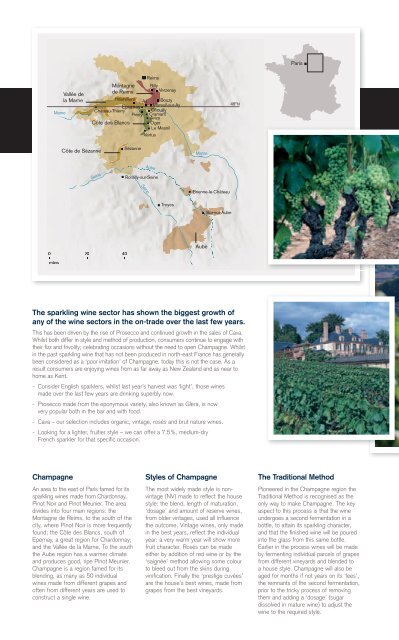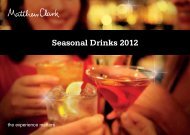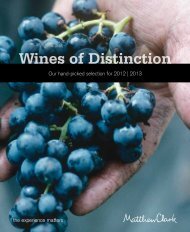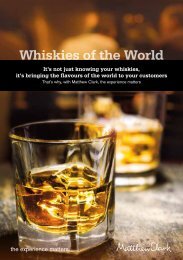Download the wine list - Matthew Clark
Download the wine list - Matthew Clark
Download the wine list - Matthew Clark
Create successful ePaper yourself
Turn your PDF publications into a flip-book with our unique Google optimized e-Paper software.
The sparkling <strong>wine</strong> sector has shown <strong>the</strong> biggest growth of<br />
any of <strong>the</strong> <strong>wine</strong> sectors in <strong>the</strong> on-trade over <strong>the</strong> last few years.<br />
This has been driven by <strong>the</strong> rise of Prosecco and continued growth in <strong>the</strong> sales of Cava.<br />
Whilst both differ in style and method of production, consumers continue to engage with<br />
<strong>the</strong>ir fi zz and frivolity; celebrating occasions without <strong>the</strong> need to open Champagne. Whilst<br />
in <strong>the</strong> past sparkling <strong>wine</strong> that has not been produced in north-east France has generally<br />
been considered as a ‘poor imitation’ of Champagne, today this is not <strong>the</strong> case. As a<br />
result consumers are enjoying <strong>wine</strong>s from as far away as New Zealand and as near to<br />
home as Kent.<br />
- Consider English sparklers, whilst last year’s harvest was ‘light’, those <strong>wine</strong>s<br />
made over <strong>the</strong> last few years are drinking superbly now.<br />
- Prosecco made from <strong>the</strong> eponymous variety, also known as Glera, is now<br />
very popular both in <strong>the</strong> bar and with food.<br />
- Cava – our selection includes organic, vintage, rosés and brut nature <strong>wine</strong>s.<br />
- Looking for a lighter, fruitier style – we can offer a 7.5%, medium-dry<br />
French sparkler for that specifi c occasion.<br />
Champagne<br />
An area to <strong>the</strong> east of Paris famed for its<br />
sparkling <strong>wine</strong>s made from Chardonnay,<br />
Pinot Noir and Pinot Meunier. The area<br />
divides into four main regions: <strong>the</strong><br />
Montagne de Reims, to <strong>the</strong> south of <strong>the</strong><br />
city, where Pinot Noir is more frequently<br />
found; <strong>the</strong> Côte des Blancs, south of<br />
Epernay, a great region for Chardonnay;<br />
and <strong>the</strong> Vallée de la Marne. To <strong>the</strong> south<br />
<strong>the</strong> Aube region has a warmer climate<br />
and produces good, ripe Pinot Meunier.<br />
Champagne is a region famed for its<br />
blending, as many as 50 individual<br />
<strong>wine</strong>s made from different grapes and<br />
often from different years are used to<br />
construct a single <strong>wine</strong>.<br />
Styles of Champagne<br />
The most widely made style is nonvintage<br />
(NV) made to reflect <strong>the</strong> house<br />
style: <strong>the</strong> blend, length of maturation,<br />
‘dosage’ and amount of reserve <strong>wine</strong>s,<br />
from older vintages, used all influence<br />
<strong>the</strong> outcome. Vintage <strong>wine</strong>s, only made<br />
in <strong>the</strong> best years, reflect <strong>the</strong> individual<br />
year: a very warm year will show more<br />
fruit character. Rosés can be made<br />
ei<strong>the</strong>r by addition of red <strong>wine</strong> or by <strong>the</strong><br />
‘saignée’ method allowing some colour<br />
to bleed out from <strong>the</strong> skins during<br />
vinification. Finally <strong>the</strong> ‘prestige cuvées’<br />
are <strong>the</strong> house’s best <strong>wine</strong>s, made from<br />
grapes from <strong>the</strong> best vineyards.<br />
The Traditional Method<br />
Pioneered in <strong>the</strong> Champagne region <strong>the</strong><br />
Traditional Method is recognised as <strong>the</strong><br />
only way to make Champagne. The key<br />
aspect to this process is that <strong>the</strong> <strong>wine</strong><br />
undergoes a second fermentation in a<br />
bottle, to attain its sparkling character,<br />
and that <strong>the</strong> finished <strong>wine</strong> will be poured<br />
into <strong>the</strong> glass from this same bottle.<br />
Earlier in <strong>the</strong> process <strong>wine</strong>s will be made<br />
by fermenting individual parcels of grapes<br />
from different vineyards and blended to<br />
a house style. Champagne will also be<br />
aged for months if not years on its ‘lees’,<br />
<strong>the</strong> remnants of <strong>the</strong> second fermentation,<br />
prior to <strong>the</strong> tricky process of removing<br />
<strong>the</strong>m and adding a ‘dosage’ (sugar<br />
dissolved in mature <strong>wine</strong>) to adjust <strong>the</strong><br />
<strong>wine</strong> to <strong>the</strong> required style.<br />
06 Champagne<br />
14 Australian Sparkling<br />
15 English Sparkling<br />
Champagne & Sparkling<br />
O<strong>the</strong>r Methods<br />
The Charmat and Transfer Methods, can<br />
be used to make good sparkling <strong>wine</strong>s.<br />
These tend to be less expensive <strong>the</strong>n<br />
those made by <strong>the</strong> Traditional Method<br />
but lack <strong>the</strong> complexity and elegance:<br />
as nei<strong>the</strong>r of <strong>the</strong>se methods involve <strong>the</strong><br />
<strong>wine</strong> undergoing <strong>the</strong> final fermentation<br />
in <strong>the</strong> bottle in which it is sold.<br />
16 French Sparkling<br />
16 Italian Sparkling<br />
18 New Zealand Sparkling<br />
Cava and Prosecco<br />
Cava from north-east Spain, mostly<br />
Catalunya, is always made by <strong>the</strong><br />
Traditional Method; <strong>the</strong> <strong>wine</strong>s can be<br />
made in a number of styles including<br />
vintage and rosé. The grapes can<br />
ei<strong>the</strong>r be indigenous to <strong>the</strong> region or<br />
Chardonnay, or Pinot Noir, or a blend;<br />
and <strong>the</strong> <strong>wine</strong>s spend a minimum of nine<br />
months ageing on <strong>the</strong>ir ‘lees’. Prosecco is<br />
both <strong>the</strong> name of <strong>the</strong> grape, and a white<br />
<strong>wine</strong>, from north-east Italy. Produced by<br />
<strong>the</strong> Charmat Method, with <strong>the</strong> secondary<br />
fermentation taking place in tank prior to<br />
bottling: it ei<strong>the</strong>r has a soft frothy fizz or<br />
can be ‘frizzante’ – semi-sparkling.<br />
18 Portuguese Sparkling<br />
18 South African Sparkling<br />
19 Spanish Sparkling<br />
Outside Europe<br />
Cooler regions of New World countries<br />
can also produce grapes suitable to<br />
make sparkling <strong>wine</strong>s. Often made<br />
by <strong>the</strong> Traditional Method, <strong>the</strong>y tend<br />
to have a fuller range of fruit flavours.<br />
Look out for examples made from <strong>the</strong><br />
classic Champagne grapes as well as<br />
o<strong>the</strong>r famous varieties.






